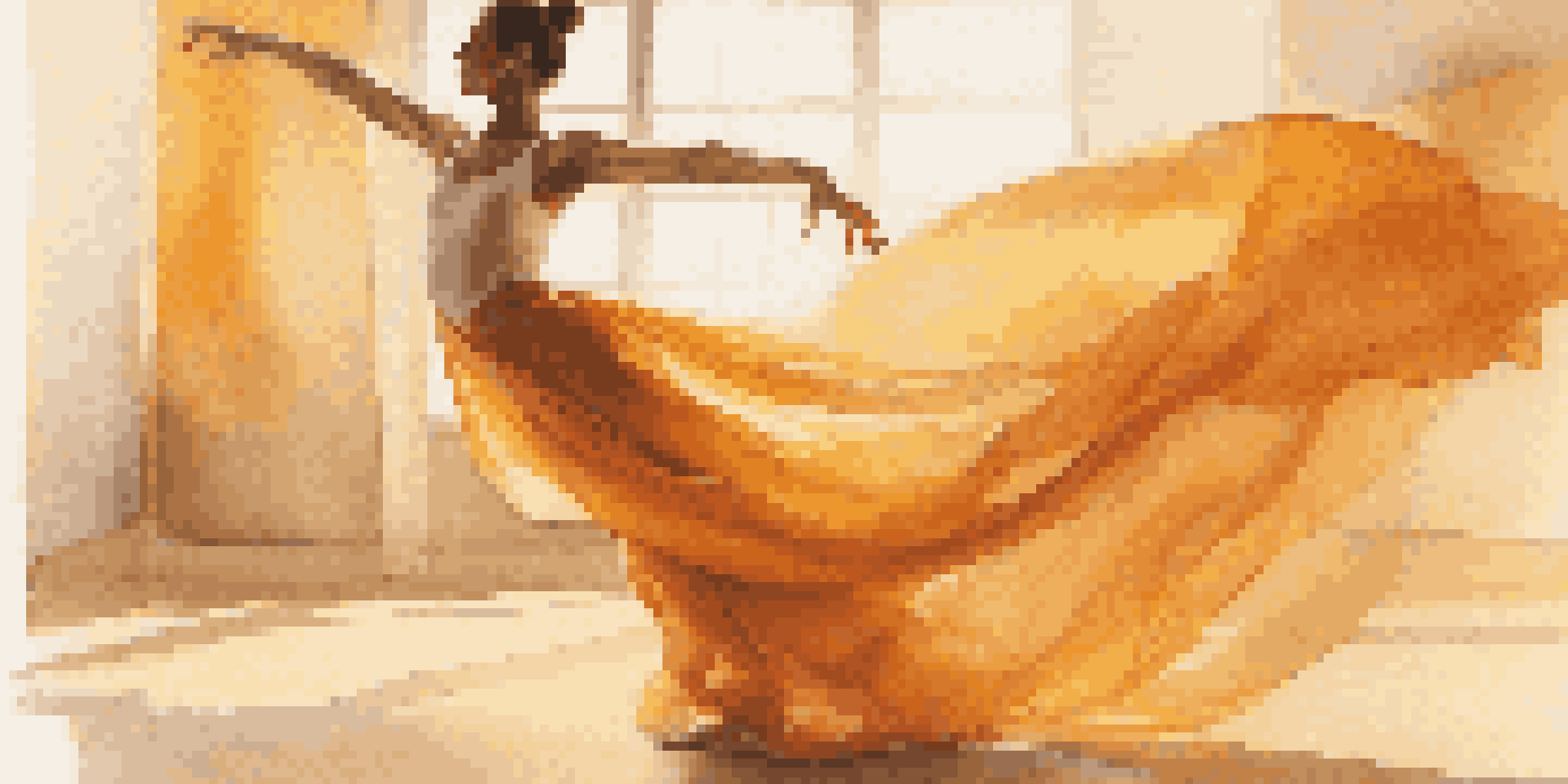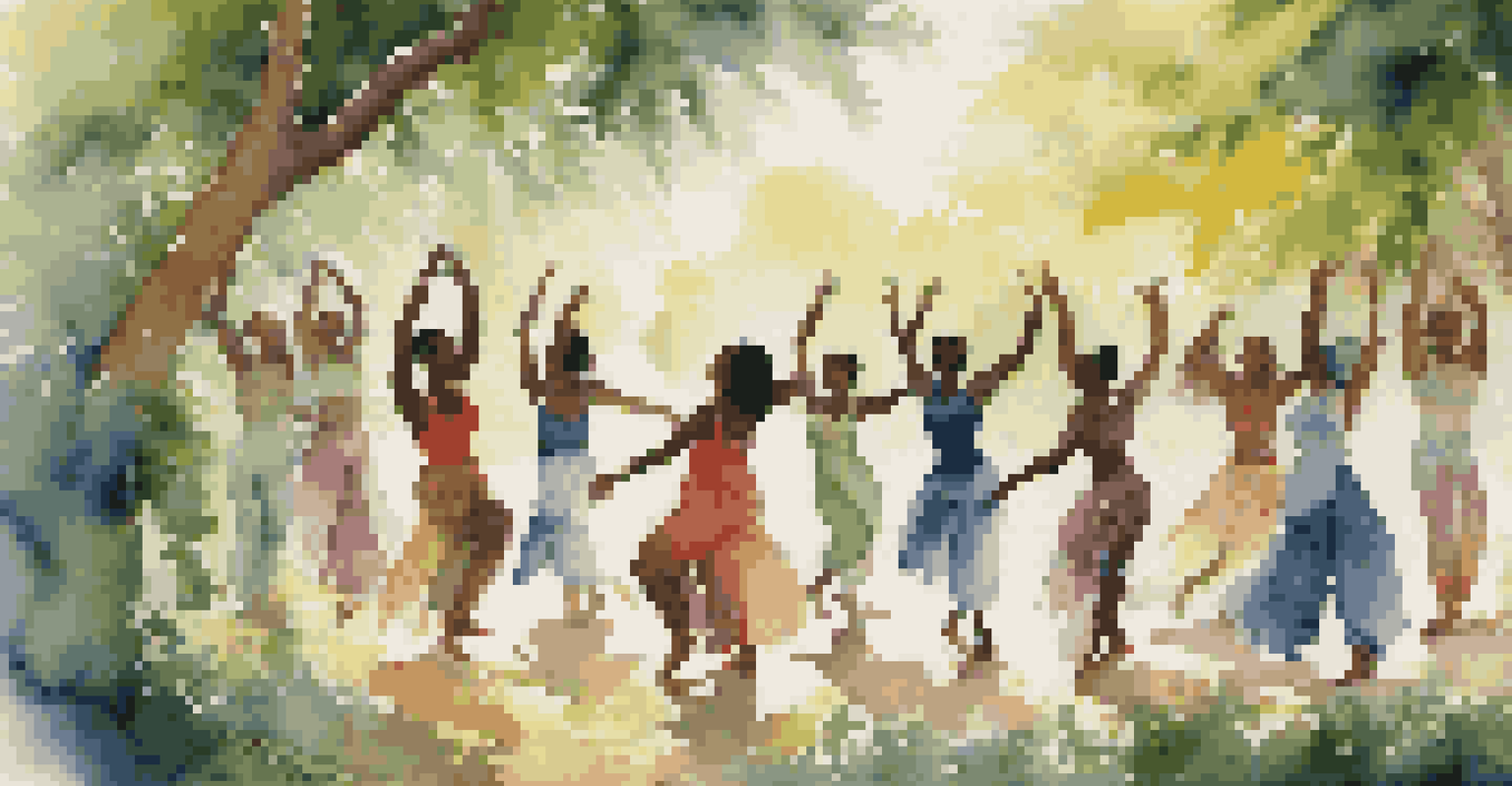Dance Improvisation and Its Role in Emotional Expression

What is Dance Improvisation and Why It Matters
Dance improvisation is the spontaneous creation of movement, allowing dancers to express their emotions in real-time. Unlike choreographed routines, improvisation invites personal interpretation, making each performance unique and authentic. This art form serves as a powerful outlet for emotions, helping individuals connect with their inner selves and the world around them.
Dance is the hidden language of the soul.
Many dancers find that improvisation opens up new avenues for creativity, enabling them to explore feelings they might not be able to articulate verbally. It's like giving voice to the unspeakable; the body becomes a canvas for emotions. Through movement, dancers can explore joy, sadness, anger, and everything in between, creating a rich tapestry of emotional expression.
In essence, dance improvisation encourages vulnerability and authenticity, fostering a deeper understanding of oneself. As dancers let go of preconceived notions and judgments, they can embrace spontaneity, leading to more profound emotional connections both within themselves and with their audience.
The Connection Between Dance and Emotions
Dance has always been intertwined with human emotions, often serving as a reflection of our innermost thoughts and feelings. When we dance, we tap into our emotional reservoir, channeling experiences and memories through movement. This intrinsic connection allows us to communicate in ways that words often fail to convey.

For instance, consider how a dancer might express grief through slow, heavy movements, contrasting with quick, lively steps that embody joy. Each movement tells a story, evoking emotions that resonate with both the dancer and the audience. This shared experience creates a powerful bond, making dance an effective medium for emotional expression.
Dance Improvisation Enhances Emotion
This spontaneous movement allows dancers to express their feelings authentically, creating a unique emotional connection.
Moreover, the physicality of dance can also influence emotional states. Engaging in movement releases endorphins and reduces stress, helping dancers process and express their feelings more freely. As a result, dance becomes not only an art form but also a therapeutic practice, promoting emotional well-being.
Improvisation as a Tool for Self-Discovery
Dance improvisation is a journey of self-discovery, allowing dancers to explore their emotions and identities. By stepping into the unknown and embracing spontaneity, individuals can uncover layers of themselves they may not have been aware of. This process can be both liberating and enlightening.
Dance is the joy of movement and the heart of life.
For example, a dancer might start with a specific emotion in mind, such as frustration, and through improvisation, discover underlying themes of resilience or hope. This exploration can lead to personal growth, as dancers learn to navigate their feelings and express them through movement. It's akin to peeling back the layers of an onion—each layer revealing something new and profound.
Furthermore, the act of improvising can break down barriers, helping dancers confront fears and insecurities. As they move without constraints, they learn to trust their instincts and embrace their authentic selves. This newfound confidence often translates into other areas of life, fostering a more profound sense of self-acceptance.
Improvisation in Group Settings: Building Connection
When practiced in group settings, dance improvisation fosters a sense of community and connection among participants. As dancers move together, they develop a shared language of expression, creating bonds that surpass verbal communication. This collective experience can be incredibly enriching and supportive.
In a group improvisation session, each dancer's unique emotional expression contributes to a larger narrative. It's like a conversation where everyone has something valuable to say, and the result is a beautiful tapestry of movement that reflects the group's collective energy. This collaboration encourages empathy, as dancers become attuned to one another's emotions.
Group Improvisation Fosters Connection
Practicing dance improvisation in groups builds community and empathy, as participants share their emotional expressions.
Moreover, these group experiences can serve as a safe space for vulnerability. Participants often feel empowered to share their emotions without fear of judgment, leading to deeper connections. This sense of belonging is essential for emotional expression, reinforcing the idea that we are not alone in our feelings.
The Role of Music in Dance Improvisation
Music plays a crucial role in enhancing dance improvisation, acting as a catalyst for emotional expression. The rhythms, melodies, and dynamics of a piece can evoke specific feelings, guiding dancers in their movements. This synergy between music and dance creates a richer and more immersive experience.
For instance, a fast-paced, upbeat song might inspire energetic, lively movements, while a slow, melancholic tune could lead to more introspective and fluid gestures. The way dancers respond to music is often instinctual, allowing them to fully embody the emotions conveyed through sound. It's as if the music becomes a partner, leading the dance.
Additionally, the improvisational aspect allows dancers to respond to musical cues in real-time, creating a dynamic interplay between sound and movement. This spontaneity not only enhances creativity but also deepens emotional expression, as dancers channel their feelings through both music and movement simultaneously.
Improvisation as a Form of Therapy
Dance improvisation has gained recognition as a form of therapy, helping individuals process emotions and improve mental health. Therapeutic dance sessions often focus on improvisation to encourage participants to express feelings that may be difficult to articulate verbally. This approach promotes emotional healing and self-awareness.
Participants in therapeutic dance often report feeling more grounded and connected to their bodies. By moving freely and exploring their emotions through dance, individuals can release pent-up feelings and stress. It's a transformative experience, akin to a weight being lifted off one's shoulders as they embrace the power of movement.
Dance as Therapeutic Expression
Dance improvisation serves as a form of therapy, helping individuals process emotions and improve mental well-being.
Moreover, dance therapy can help individuals cope with various issues, such as trauma, anxiety, and depression. By providing a creative outlet for expression, dance improvisation empowers participants to reclaim their narratives and foster resilience. This journey toward healing is not just about movement—it's about rediscovering oneself.
Embracing Dance Improvisation in Daily Life
Incorporating dance improvisation into daily life can be a wonderful way to enhance emotional expression and well-being. You don't need to be a professional dancer to enjoy the benefits; simply allowing yourself to move freely to music in your living room can be liberating. This practice encourages mindfulness and self-discovery.
Consider setting aside a few minutes each day to dance without any expectations or judgments. Let your body respond to the music, exploring how different rhythms inspire various movements. This personal time can serve as a powerful form of self-care, helping you connect with your emotions and release stress.

Additionally, inviting friends or family to join you in a fun dance session can deepen connections and foster a supportive environment for emotional expression. Sharing this improvisational experience with others can create lasting memories and strengthen relationships, making dance an integral part of your emotional well-being.